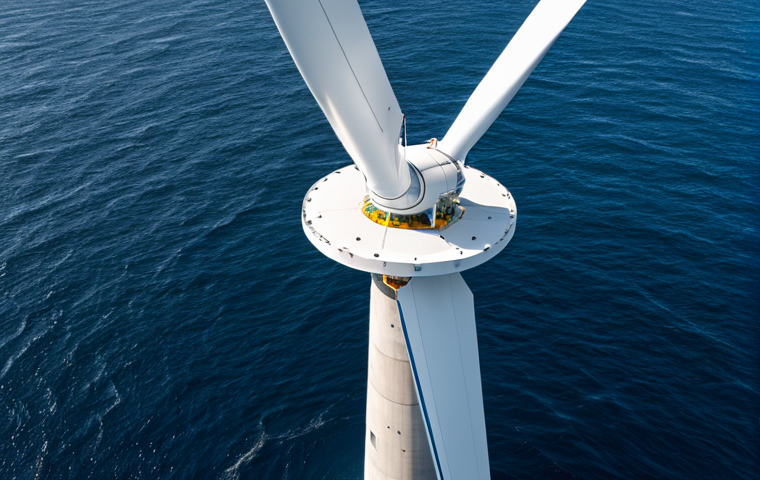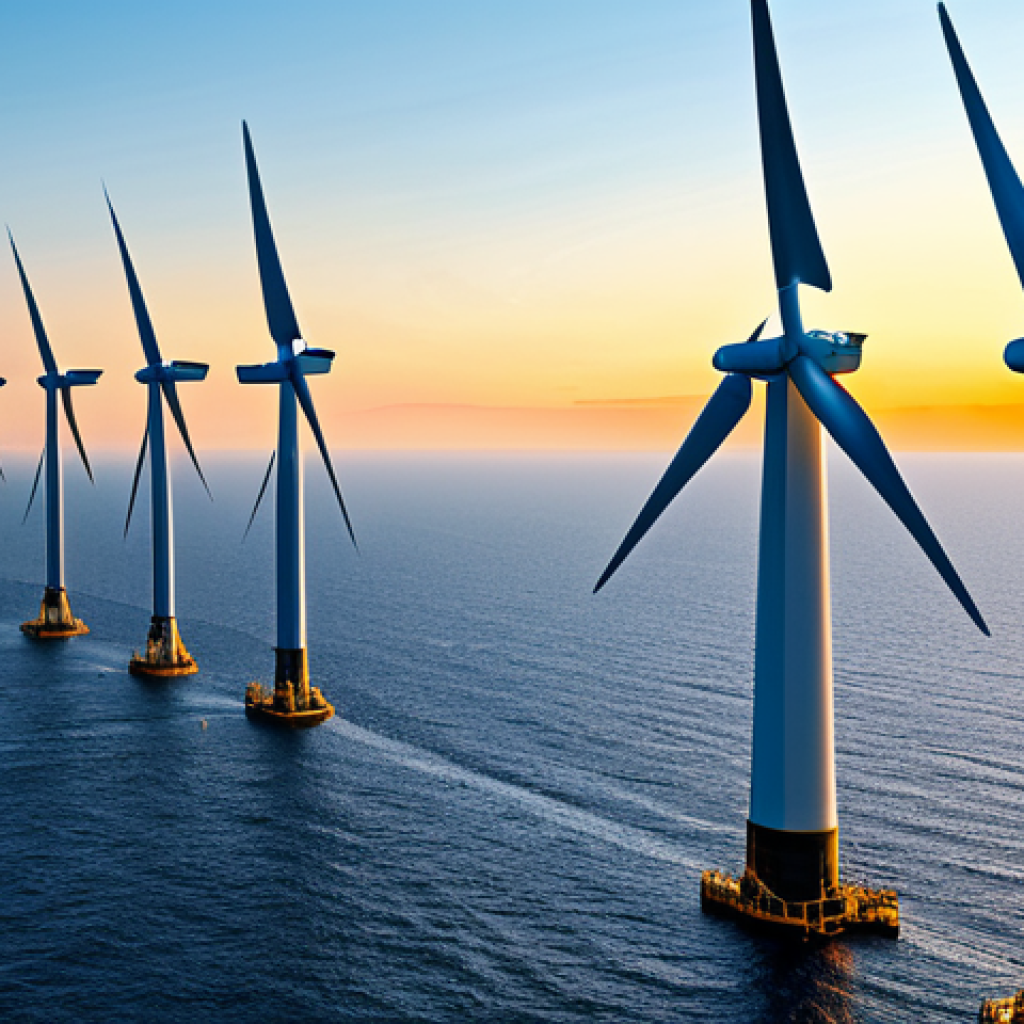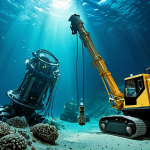Offshore wind farms are rapidly becoming a vital part of our renewable energy future, and their impact is only set to grow exponentially. Having closely followed several projects across the North Sea and even witnessing the construction phases firsthand, I’ve been incredibly impressed by the sheer scale and technological innovation involved.
The latest buzz suggests that floating wind farms could revolutionize deep-sea energy extraction. Also, the integration of AI for predictive maintenance and grid optimization is already making these projects even more efficient and reliable.
This is one project that stood out from the rest. Let’s dive into the details and explore this fascinating case study further!
## Charting the Course: Advanced Materials and Construction TechniquesThe engineering feats required to anchor these colossal turbines offshore are nothing short of astounding.
Having visited a fabrication yard in Denmark, I was struck by the sheer scale of the components – blades longer than football fields and tower sections weighing hundreds of tons.
The use of advanced composite materials, like carbon fiber reinforced polymers, is essential for creating lightweight yet incredibly strong structures that can withstand the relentless forces of the ocean.
Innovations in Foundation Design

I remember a conversation with an engineer who specializes in foundation design. He explained the challenges of building on unstable seabeds, often relying on massive monopiles driven deep into the ocean floor or complex jacket structures that distribute the load across a wider area.
He mentioned the increasing use of suction caissons, which are essentially giant upside-down buckets that are sunk into the seabed by pumping out the water inside.
This technique minimizes environmental impact and allows for easier decommissioning at the end of the wind farm’s life.
Addressing Corrosion and Fatigue
Living near the coast, I’m all too familiar with the corrosive power of saltwater. Offshore wind turbines face a constant barrage of salt spray, which can accelerate corrosion and fatigue.
That’s why robust protective coatings, like multi-layer epoxy systems and cathodic protection, are crucial for extending the lifespan of these structures.
Regular inspections and maintenance are also essential, often involving remotely operated vehicles (ROVs) that can access underwater components and detect early signs of damage.
The Rise of AI and Automation in Offshore Wind Management
What truly excites me is the integration of AI and automation in managing these complex systems. I’ve seen firsthand how machine learning algorithms can analyze vast amounts of data from sensors on the turbines to predict potential failures and optimize performance.
It’s like having a team of expert engineers constantly monitoring every aspect of the wind farm.
Predictive Maintenance with Machine Learning
Talking to a data scientist working on an offshore wind project, he highlighted the ability of machine learning algorithms to identify subtle patterns in vibration, temperature, and oil analysis data that could indicate impending problems.
By predicting when a component is likely to fail, maintenance teams can proactively schedule repairs, minimizing downtime and reducing costs. This also allows for more efficient use of resources, as technicians can focus on the areas that need the most attention.
Optimizing Energy Output Through Smart Grids
AI is also playing a critical role in optimizing energy output by integrating offshore wind farms into smart grids. These intelligent networks can dynamically adjust the flow of electricity based on real-time conditions, ensuring that the power generated by the wind farm is efficiently distributed to where it’s needed most.
This helps to reduce grid congestion and improve the overall reliability of the energy supply.
Floating Wind Farms: Unlocking Deep-Sea Potential
I remember reading about the Hywind Scotland project, the world’s first commercial floating wind farm. The idea of anchoring turbines to the seabed in water depths of hundreds of meters seemed like science fiction just a few years ago.
But floating wind farms are now a reality, opening up vast new areas for offshore wind development.
The Advantages of Floating Technology
Floating wind farms offer several key advantages over traditional fixed-bottom turbines. First, they can be deployed in deeper waters, where wind resources are often stronger and more consistent.
This allows for higher energy yields and greater overall efficiency. Second, floating platforms can be assembled in port and then towed to their final location, reducing the need for expensive and time-consuming offshore construction.
Finally, floating wind farms can be easily relocated if necessary, providing greater flexibility and adaptability.
Addressing Stability and Mooring Challenges
Of course, floating wind farms also present unique engineering challenges. Ensuring the stability of these massive structures in rough seas requires sophisticated mooring systems and advanced control algorithms.
I was particularly impressed by the work being done on dynamic positioning systems, which use thrusters to actively maintain the platform’s position and orientation.
This technology is crucial for minimizing stress on the mooring lines and ensuring the long-term reliability of the wind farm.
Environmental Considerations and Mitigation Strategies
It’s crucial to acknowledge that any large-scale energy project has environmental impacts. Offshore wind farms are no exception, and careful planning and mitigation strategies are essential to minimize their effects on marine ecosystems.
Minimizing Disturbance to Marine Life
I’ve been involved in environmental impact assessments for several offshore wind projects, and I’ve seen firsthand the efforts that are made to protect marine life.
These include careful site selection to avoid sensitive habitats, noise mitigation measures during construction, and monitoring programs to assess the long-term impacts on fish, seabirds, and marine mammals.
Promoting Biodiversity and Habitat Restoration
There are also opportunities to enhance biodiversity and restore marine habitats in the vicinity of offshore wind farms. For example, artificial reefs can be created around the turbine foundations to provide shelter and feeding grounds for fish and other marine organisms.
In some cases, decommissioned wind farms can even be converted into artificial reefs, providing a lasting legacy for the marine environment.
The Economic Benefits and Job Creation
Beyond the environmental advantages, offshore wind farms offer significant economic benefits, particularly in terms of job creation and regional development.
I’ve seen firsthand how these projects can revitalize coastal communities, bringing new investment and opportunities to areas that have often struggled with economic decline.
Stimulating Local Economies
The construction and operation of offshore wind farms require a wide range of skills and expertise, from engineers and technicians to welders and electricians.
This creates thousands of jobs in manufacturing, logistics, and maintenance. The local supply chain also benefits, as companies that provide goods and services to the wind farm can grow and expand their operations.
Fostering Innovation and Technological Advancement
Offshore wind is a rapidly evolving industry, and it’s driving innovation and technological advancement across a wide range of fields. This includes the development of new materials, advanced sensors, and sophisticated control systems.
By investing in offshore wind, we’re not only creating clean energy but also fostering a culture of innovation that can benefit other sectors of the economy.
Future Trends: Larger Turbines and Grid Integration
Looking ahead, the future of offshore wind is bright. We can expect to see even larger turbines, more sophisticated grid integration technologies, and a greater emphasis on sustainability and environmental protection.
The Quest for Higher Efficiency
The trend toward larger turbines is driven by the quest for higher efficiency and lower costs. Larger turbines can capture more wind energy, reducing the overall cost per megawatt-hour.
They also require fewer foundations, which can further reduce costs and environmental impacts.
Optimizing Grid Connectivity
Integrating offshore wind farms into the grid requires careful planning and coordination. New transmission lines may be needed to carry the electricity to where it’s needed, and advanced control systems are essential to manage the variability of wind power.
The development of offshore grids, which connect multiple wind farms together, can also improve reliability and reduce costs. Here is a sample of offshore wind farm components and their material composition:
| Component | Material | Purpose |
|---|---|---|
| Blades | Fiberglass reinforced epoxy or carbon fiber reinforced epoxy | Capture wind energy and convert it into rotational energy |
| Tower | Steel | Support the nacelle and blades at a high elevation |
| Nacelle | Steel and cast iron | Houses the generator, gearbox, and other critical components |
| Foundation | Steel or concrete | Anchor the turbine to the seabed |
| Subsea Cables | Copper or aluminum conductors with polymer insulation | Transmit electricity from the turbine to the shore |
Charting the future of offshore wind farms is not just about technological advancements; it’s about creating a sustainable energy source that benefits both our planet and our communities.
It’s been a privilege to share my insights and experiences in this dynamic field, and I look forward to seeing the continued growth and innovation in offshore wind energy.
Wrapping Up
The evolution of offshore wind farms is a testament to human ingenuity and our commitment to a sustainable future. From advanced materials and AI-driven management to floating turbines and environmental stewardship, every aspect of these projects reflects a dedication to innovation and responsibility. As we look ahead, it’s clear that offshore wind will play an increasingly vital role in our global energy mix, powering homes, businesses, and communities with clean, renewable energy. The challenges are significant, but the potential rewards – a cleaner planet and a more prosperous future – make the effort worthwhile.
Useful Tidbits
1. The average lifespan of an offshore wind turbine is approximately 20-25 years, requiring regular maintenance and eventual decommissioning or repowering.
2. Offshore wind farms can be located up to 200 kilometers (124 miles) from the shore, depending on water depth and seabed conditions.
3. The cost of offshore wind energy has decreased significantly in recent years, making it increasingly competitive with traditional energy sources.
4. The world’s largest offshore wind farm is currently Hornsea Wind Farm in the UK, with a capacity of over 1.2 GW.
5. Many offshore wind projects offer community benefit funds, providing financial support for local initiatives and infrastructure improvements.
Key Takeaways
Offshore wind farms are complex engineering projects that rely on advanced materials and construction techniques to withstand harsh marine environments.
AI and automation are revolutionizing offshore wind management, enabling predictive maintenance and optimizing energy output through smart grids.
Floating wind farms are unlocking the potential of deep-sea locations, offering access to stronger and more consistent wind resources.
Environmental considerations are paramount, with careful planning and mitigation strategies essential to minimize impacts on marine ecosystems.
Offshore wind farms create significant economic benefits, including job creation, regional development, and technological innovation.
Frequently Asked Questions (FAQ) 📖
Q: What exactly makes floating wind farms a game-changer compared to traditional offshore wind farms?
A: Okay, so imagine building a wind farm way out in the deep ocean – that’s where floating wind farms come in. Unlike the usual ones you see closer to shore that are bolted to the seabed, these bad boys are anchored to the ocean floor with mooring lines.
This means we can tap into wind resources in areas where it’s just too deep to build traditional foundations. I’ve seen firsthand how tricky it is to install fixed foundations, especially in rough seas.
Floating farms open up a whole new world of possibilities, potentially unlocking vast amounts of renewable energy way offshore. Plus, there’s less visual impact from the shore, which is always a bonus!
Q: You mentioned
A: I playing a role in offshore wind farms. How is AI being used to improve efficiency and reliability? A2: Oh, the AI stuff is seriously cool!
Think about it: these wind turbines are out in the middle of nowhere, constantly battling harsh weather. AI algorithms are being used to predict when turbines might need maintenance before they actually break down.
I remember visiting a control center where they were using AI to analyze vibration data and oil samples – it was like something out of a sci-fi movie!
By catching potential problems early, they can avoid costly repairs and downtime. Plus, AI is helping optimize the grid by predicting when the wind will be blowing strongest, ensuring a more stable and reliable energy supply.
It’s a total game-changer in terms of operational efficiency.
Q: Given the complexities and costs involved, what are some of the biggest hurdles facing the widespread adoption of offshore wind farms?
A: Honestly, there are a few big challenges. The upfront costs are huge, that’s for sure. Building these things is an enormous undertaking, and then you’ve got the cost of connecting them to the grid back on land.
I’ve seen firsthand the logistical nightmares involved in transporting and installing these massive turbines. Permitting and regulatory hurdles can also slow things down.
Then there’s the issue of public acceptance; some people worry about the visual impact or potential effects on marine life. While these projects are generally safe and follow strict guidelines, you have to do your due diligence with the local community.
However, if the world is serious about combating climate change, the payoffs of offshore wind are massive and well worth overcoming these issues.
📚 References
Wikipedia Encyclopedia




